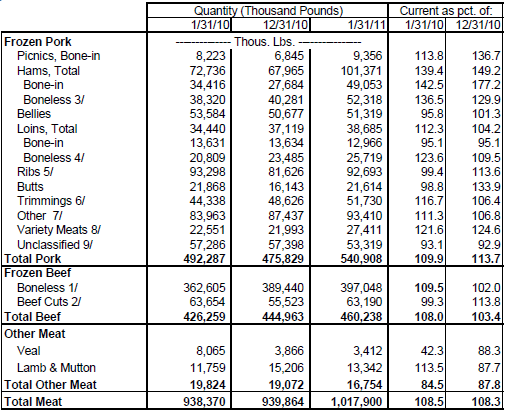



CME: Increase in US Meat and Poultry Stocks
US - Stocks of meat and poultry in US commercial freezers increased by 6.1 per cent during January, reaching 2.054 billion pounds according to USDA’s monthly Cold Storage report, released yesterday, write Steve Meyer and Len Steiner.The report was released after the close of CME futures markets on Tuesday and was not a contributor to the sell-off in Lean Hogs, Live Cattle and Feeder Cattle in Tuesday’s session — more on those changes below. Monthly data for each species are charted below along with the key data from today’s report.

USDA Cold Storage Report
22 February 2011


Some highlights of Tuesday’s report are:
- Total meat and poultry in frozen inventories amounted to 2.054 billion pounds, 9.6 per cent higher than one year ago. That increase was shared by the four major species but the largest year-on-year increase belonged once again to chicken whose stocks were 23.5 per cent larger than last year at 778.3 million pounds.
- Every chicken product category except thigh meat showed an increase from one year ago. The largest percentage gain versus 31 January 2010 was in leg stocks at +185 per cent but the largest increases in unit terms were for leg quarters (+42.3 million pounds), wings (+35.1 million pounds) and “other” chicken (+31.6 million pounds). These three categories accounted for over 70 per cent of the increase in frozen chicken inventories from one year ago.
- Chicken inventories which, from a historical perspective, were the most concerning of any of the species at the end of December, did decline during January by 3.1 per cent. Several categories contributed to the decline.
- Stocks of breasts and breast meat (123.7 million pounds, 15.2 per cent of the total), leg quarters (131.5 million pounds, 16.9 per cent of the total and “other” chicken (337.989 million pounds, 43 per cent of the total) comprised most of the 31 January total. Only the leg quarter stocks are high by historical standard, with January 31 marking the second highest stocks level for leg quarters since March 2006. Exports are still a challenge and, of all the major species, chicken stocks remain the most concerning.
- Pork inventories, at 540.9 million pounds, were 9.9 per cent larger than last year and 13.7 per cent larger than in December. Based on weekly data, pork production during January was 3.4 per cent higher than one year ago. The increase in cold storage stocks suggest some reduction in either domestic disappearance or exports. Ham stocks rose to 101.37 million pounds, up 39 per cent from last year and 49 per cent from last month. The increase in ham stocks accounted for 59 per cent of the increase in all pork inventories. Pork inventories usually grow during the winter months before declining as hog numbers fall in the spring. January’s increase of 65 million pounds from December’s level is slightly more than the average Dec-Jan increase over the past 10 years, 52.2 million pounds.
- Turkey inventories remain very tight relative to last year. The 254.2 million pounds in freezers on 31 January were 15.8 per cent lower than one year ago and January’s post-holiday increase was about normal for the industry.
- Frozen beef stocks grew to 460.2 million pounds with nearly 400 million of that being boneless beef. Total stocks are 8 per cent larger than last year and 3.4 per cent larger than one month earlier. Beef inventories remain firmly within their normal range for this time of year.
The sharp selloff in commodities futures today was driven primarily by concerns over continued unrest in the Middle East and the potential it has to impact oil exports and prices and grain export demand. The selloff was most widespread and largest in the grains with all CME Group Corn futures contracts through July 2012 falling by the limit of 30 cents per bushel. 2010-crop soybean futures (ie. contracts through August 2011) were down the 70 cent/bushel limit while 2011-crop futures fell by 58 to 68 cents/bushel. Prices for 2011 soybean meal contracts fell by $11.50 to $15.50/ton for 2011 contracts. Nearby contracts for Chicago wheat were also down the 60 cent/bushel limit. These declines could provide a much-welcome opportunity for livestock and poultry producers to lock in significantly lower feed costs for the remainder of 2011.
But what the market giveth, it also taketh away — at least partially. The June LH contract set a new all-time record in early trading at $104.10 but then closed down $0.375 at $102.40. The loss was typical for LH contracts through October. Dec ‘11 through June ‘12 were down $1.25 to $2.00. Live cattle took a harder hit with contract prices falling by $0.95 to $1.925 for the day.








